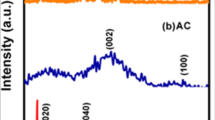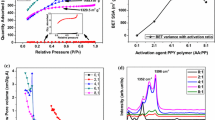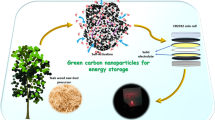Abstract
The synergistic effects between two Keggin-type heteropoly acids (HPAs) and carbon surface were examined and elucidated. An improved high rate capability (and potential high capacitor electrode for supercapacitors) of the hybrid materials, obtained by anchoring of α-dodecamolybdophosphoric (MoPA), α-dodecatungstophosphoric (WPA), and their mixture to activated carbon (AC), was achieved through the different mechanism of interaction. In order to elaborate this, a detailed analysis of AC-HPA composites has been performed by scanning electron microscopy (SEM), Brunauer–Emmett–Teller (BET) analysis, temperature-programmed desorption (TPD), Fourier-transform infrared spectroscopy (FTIR), micro Raman spectroscopy, and zeta potential measurements. The zeta potential measurements revealed positive charge of carbon surface thus indicating attractive interactions with negatively charged Keggin anion. The surface analysis has shown that WPA spontaneously reduces the carbon surface, while interaction with MoPA leads to its oxidation. As the consequence of the tailoring of the functional groups at carbon surface through HPAs’ action, the distortion of cyclic voltammograms (CVs) decreased in the following order: AC-MoPA, AC-MoPA-WPA, and AC-WPA. A prominent rectangular shape of AC-WPA, even at an extremely high scan rate of 400 mVs−1, was measured, which is rarely demonstrated for carbon-based composites. By applying the theory of electrode potentials, the HPA-AC synergistic effect was explained and discussed in terms of charge storage improvement of HPA-modified carbon.







Similar content being viewed by others
References
Lin CG, Hu J, Song YF (2017) Polyoxometalate-functionalized nanocarbon materials for energy conversion, energy storage, and sensor systems. Adv Inorg Chem 69:181–212. https://doi.org/10.1016/bs.adioch.2016.12.004
Ruiz V, Suárez-Guevara J, Gomez-Romero P (2012) Hybrid electrodes based on polyoxometalate-carbon materials for electrochemical supercapacitors. Electrochem Commun 24:35–38. https://doi.org/10.1016/j.elecom.2012.08.003
Suárez-Guevara J, Ruiz V, Gomez-Romero P (2014) Hybrid energy storage: high voltage aqueous supercapacitors based on activated carbon-phosphotungstate hybrid materials. J Mater Chem A 2(4):1014–1021. https://doi.org/10.1039/c3ta14455k
Jovanović Z, Holclajtner-Antunović I, Bajuk-Bogdanović D, Jovanović S, Mravik Ž, Vujković M (2017) Effect of thermal treatment on the charge storage properties of graphene oxide/12-tungstophosphoric acid nanocomposite. Electrochem Commun 83:36–40. https://doi.org/10.1016/j.elecom.2017.08.017
Dubal DP, Nagar B, Suarez-Guevara J, Tonti D, Enciso E, Palomino P, Gomez-Romero P (2017) Ultrahigh energy density supercapacitors through a double hybrid strategy. Mater Today Energy 5:58–65. https://doi.org/10.1016/j.mtener.2017.05.001
He C, Qiu S, Sun S, Zhang Q, Lin G, Lei S, Han X, Yang Y (2018) Electrochemically active phosphotungstic acid assisted prevention of graphene restacking for high-capacitance supercapacitors. Energy Environ Mater 1(2):88–95. https://doi.org/10.1002/eem2.12007
Qi W, Liu W, Liu S, Zhang B, Gu X, Guo X, Su D (2014) Heteropoly acid/carbon nanotube hybrid materials as efficient solid-acid catalysts. ChemCatChem 6(9):2613–2620. https://doi.org/10.1002/cctc.201402270
Chikin AI, Chernyak AV, Jin Z, Naumova YS, Ukshe AE, Smirnova NV, Volkov VI, Dobrovolsky YA (2012) Mobility of protons in 12-phosphotungstic acid and its acid and neutral salts. J Solid State Electrochem 16(8):2767–2775. https://doi.org/10.1007/s10008-012-1687-6
Song IK, Barteau MA (2004) Redox properties of Keggin-type heteropolyacid (HPA) catalysts: effect of counter-cation, heteroatom, and polyatom substitution. J Mol Catal A Chem 212(1-2):229–236. https://doi.org/10.1016/j.molcata.2003.10.040
Cuentas-Gallegos AK, López-Cortina S, Brousse T, Pacheco-Catalán D, Fuentes-Quezada E, Mosqueda H, Orozco-Gamboa G (2016) Electrochemical study of H3PMo12 retention on Vulcan carbon grafted with NH2 and OH groups. J Solid State Electrochem 20(1):67–79. https://doi.org/10.1007/s10008-015-2994-5
Rosenheim A, Jaenicke J (1917) Zur Kenntnis der Iso- und Heteropolysäuren. XV. Mitteilung Über Heteropolywolframate und einige Heteropolymolybdänate. Z Anorg Allg Chem 101(1):235–275
Mioč UB, Todorović MR, Davidović M et al (2005) Heteropoly compounds - from proton conductors to biomedical agents. Solid State Ionics 176(39-40):3005–3017. https://doi.org/10.1016/j.ssi.2005.09.056
De Oliveira M, Rodrigues-Filho UP, Schneider J (2014) Thermal transformations and proton species in 12-phosphotungstic acid hexahydrate studied by 1H and 31P solid-state nuclear magnetic resonance. J Phys Chem C 118(22):11573–11583. https://doi.org/10.1021/jp501887x
(2007) PCP (Queriable database) CERIC https://www.cheric.org/research/kdb/hcprop/showprop.php?cmpid=194. R 12 M No Title
Brunauer S, Emmett PH, Teller E (1938) Adsorption of gases in multimolecular layers. J Am Chem Soc 60(2):309–319. https://doi.org/10.1021/ja01269a023
Dubinin MM (1975) Physical adsorption of gases and vapours in microspores,. In: Cadenhead DA (ed) Progress in surface and membrane science. New York, pp 1–70. https://doi.org/10.1016/B978-0-12-571809-7.50006-1
Jovanovic Z, Bajuk-Bogdanović D, Jovanović S, Mravik Ž, Kovač J, Holclajtner-Antunović I, Vujković M (2017) The role of surface chemistry in the charge storage properties of graphene oxide. Electrochim Acta 258:1228–1243. https://doi.org/10.1016/j.electacta.2017.11.178
Oh YJ, Yoo JJ, Il KY et al (2014) Oxygen functional groups and electrochemical capacitive behavior of incompletely reduced graphene oxides as a thin-film electrode of supercapacitor. Electrochim Acta 116:118–128. https://doi.org/10.1016/j.electacta.2013.11.040
Andreas HA, Conway BE (2006) Examination of the double-layer capacitance of an high specific-area C-cloth electrode as titrated from acidic to alkaline pHs. Electrochim Acta 51(28):6510–6520. https://doi.org/10.1016/j.electacta.2006.04.045
Lin Z, Liu Y, Yao Y, Hildreth OJ, Li Z, Moon K, Wong CP (2011) Superior capacitance of functionalized graphene. J Phys Chem C 115(14):7120–7125. https://doi.org/10.1021/jp2007073
Śliwak A, Grzyb B, Ćwikła J, Gryglewicz G (2013) Influence of wet oxidation of herringbone carbon nanofibers on the pseudocapacitance effect. Carbon N Y 64:324–333. https://doi.org/10.1016/j.carbon.2013.07.082
Sadakane M, Steckhan E (1998) Electrochemical properties of polyoxometalates as electrocatalysts. Chem Rev 98(1):219–238. https://doi.org/10.1021/cr960403a
Genovese M, Wei Foong Y, Lian K (2016) The unique properties of aqueous polyoxometalate (POM) mixtures and their role in the design of molecular coatings for electrochemical energy storage. Electrochim Acta 199:261–269. https://doi.org/10.1016/j.electacta.2016.01.145
Chen T, Fan C (2013) One-pot generation of mesoporous carbon supported nanocrystalline H3PW12O40heteropoly acid with high performance in microwave esterification of acetic acid and isoamyl alcohol. J Porous Mater 20(5):1225–1230. https://doi.org/10.1007/s10934-013-9706-2
Jiang M, Zhu D, Cai J, Zhang H, Zhao X (2014) Electrocatalytic hydrogen evolution and oxygen reduction on polyoxotungstates/graphene nanocomposite multilayers. J Phys Chem C 118(26):14371–14378. https://doi.org/10.1021/jp503019f
Kim Y, Shanmugam S (2013) Polyoxometalate-reduced graphene oxide hybrid catalyst: synthesis, structure, and electrochemical properties. ACS Appl Mater Interfaces 5(22):12197–12204. https://doi.org/10.1021/am4043245
Vujković MJ, Vidoeski BA, Jovanović SP, Bajuk-Bogdanović DV, Budimir MD, Marković ZM, Pavlović VB, Todorović-Marković BM, Holclajtner-Antunović ID (2016) Synthesis and characterization of electrochemically exfoliated graphene-molybdophosphate hybrid materials for charge storage devices. Electrochim Acta 217:34–46. https://doi.org/10.1016/j.electacta.2016.09.067
Acik M, Lee G, Mattevi C, Pirkle A, Wallace RM, Chhowalla M, Cho K, Chabal Y (2011) The role of oxygen during thermal reduction of graphene oxide studied by infrared absorption spectroscopy. J Phys Chem C 115(40):19761–19781. https://doi.org/10.1021/jp2052618
Holclajtner-Antunović I, Mioč UB, Todorović M, Jovanović Z, Davidović M, Bajuk-Bogdanović D, Laušević Z (2010) Characterization of potassium salts of 12-tungstophosphoric acid. Mater Res Bull 45(11):1679–1684. https://doi.org/10.1016/J.MATERRESBULL.2010.06.064
Rocchiccioli-Deltcheff C (1976) Spectres i.r. et Raman d’hétéropolyanions α -XM12O40n− de structure de type Keggin (X = BIII, SiIV, GeIV, PV, AsV et M = WVI et MoVI). Spectrochim Acta 32A 32(3):587–597
Dresselhaus MS, Jorio A, Souza Filho AG, Saito R (2010) Defect characterization in graphene and carbon nanotubes using Raman spectroscopy. Philos Trans A Math Phys Eng Sci 368(1932):5355–5377. https://doi.org/10.1098/rsta.2010.0213
Ofir E, Oren Y, Adin A (2007) Electroflocculation: the effect of zeta-potential on particle size. Desalination 204(1-3):33–38. https://doi.org/10.1016/j.desal.2006.03.533
Figueiredo JL, Pereira MFR (2010) The role of surface chemistry in catalysis with carbons. Catal Today 150(1-2):2–7. https://doi.org/10.1016/j.cattod.2009.04.010
Gorgulho HF, Mesquita JP, Gonçalves F, Pereira MFR, Figueiredo JL (2008) Characterization of the surface chemistry of carbon materials by potentiometric titrations and temperature-programmed desorption. Carbon N Y 46(12):1544–1555. https://doi.org/10.1016/j.carbon.2008.06.045
Moreno-Castilla C, Carrasco-Marín F, Mueden A (1997) The creation of acid carbon surfaces by treatment with (NH4)2S2O8. Carbon N Y 35(10-11):1619–1626. https://doi.org/10.1016/S0008-6223(97)00121-8
Li H, Gupta J, Wang S, Zhang N, Bubeck C (2014) Photoreduction of graphene oxide with polyoxometalate clusters and its enhanced saturable absorption. J Colloid Interface Sci 427:25–28. https://doi.org/10.1016/j.jcis.2013.11.030
Wang S, Li H, Li S, Liu F, Wu D, Feng X, Wu L (2013) Electrochemical-reduction-assisted assembly of a polyoxometalate/graphene nanocomposite and its enhanced lithium-storage performance. Chem - A Eur J 19(33):10895–10902. https://doi.org/10.1002/chem.201300319
Li H, Pang S, Feng X, Müllen K, Bubeck C (2010) Polyoxometalate assisted photoreduction of graphene oxide and its nanocomposite formation. Chem Commun 46(34):6243. https://doi.org/10.1039/c0cc01098g
Ago H, Kugler T, Cacialli F, Salaneck WR, Shaffer MSP, Windle AH, Friend RH (2002) Work functions and surface functional groups of multiwall carbon nanotubes. J Phys Chem B 103(38):8116–8121. https://doi.org/10.1021/jp991659y
Funding
The research was financially supported by the Ministry of Education, Science and Technological Development of Republic of Serbia (Projects OI 172043, III45006, and III45014) and by the Slovenian Research Agency (Project P2-0091). The authors would like to thank Damjan Vengust from the Advanced Materials Department, Jožef Stefan Institute for the help with the SEM-EDS analysis.
Author information
Authors and Affiliations
Corresponding author
Ethics declarations
Conflict of interest
The authors declare that they have no conflict of interest.
Additional information
Publisher’s note
Springer Nature remains neutral with regard to jurisdictional claims in published maps and institutional affiliations.
Electronic supplementary material
ESM 1
(DOC 2311 kb)
Rights and permissions
About this article
Cite this article
Bajuk-Bogdanović, D., Holclajtner-Antunović, I., Jovanović, Z. et al. Tailoring the electrochemical charge storage properties of carbonaceous support by redox properties of heteropoly acids: where does the synergy come from?. J Solid State Electrochem 23, 2747–2758 (2019). https://doi.org/10.1007/s10008-019-04369-4
Received:
Revised:
Accepted:
Published:
Issue Date:
DOI: https://doi.org/10.1007/s10008-019-04369-4




